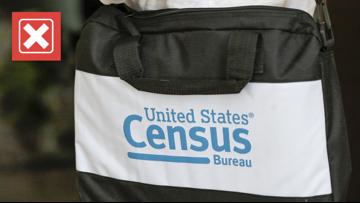On Wednesday, Sept. 27, seven Republican presidential candidates appeared on the debate stage at the Ronald Reagan Presidential Foundation & Institute in Simi Valley, Calif. It was the second GOP primary debate ahead of the 2024 presidential election.
The candidates on stage were Florida Gov. Ron DeSantis, former Vice President Mike Pence, entrepreneur Vivek Ramaswamy, Sen. Tim Scott of South Carolina, former United Nations Ambassador Nikki Haley, former New Jersey Gov. Chris Christie and North Dakota Gov. Doug Burgum.
Former President Donald Trump qualified for Wednesday’s debate but chose to skip it. He did not attend the first primary debate in August, either.
During the second primary debate, candidates discussed issues including immigration, inflation, wages, foreign policy and crime.
VERIFY fact-checked several claims from the debate.
THE CLAIM
Chris Christie: “The Trump Administration only built 52 miles of border wall.”
Mike Pence: “We built hundreds of miles of border wall.”
THE SOURCES
THE ANSWER
Both of these claims need context. The Trump administration completed 52 miles of primary border wall where there were no preexisting barriers. However, when including secondary border walls and replacement of preexisting border barriers, the Trump administration constructed about 458 total miles of wall.
WHAT WE FOUND
U.S. Customs and Border Protection (CBP) reports record construction of both primary and secondary border walls. Primary border barriers are the first barriers someone encounters when crossing the border, while secondary barriers are those located behind the primary barriers, according to a U.S. Government Accountability Office report.
A Jan. 22, 2021 report by CBP said 52 miles of new primary border wall where no barrier previously existed were completed during the Trump Administration. The Trump Administration also built 351 miles of border wall “in place of dilapidated and/or outdated designs.” Between the brand new and replacement barriers, that’s a total of 403 miles.
Additionally, the CBP reported the Trump Administration completed 33 miles of new secondary walls and replaced 22 miles of dilapidated and/or outdated secondary walls.
A June 11, 2021 press release from the Biden Administration’s White House also said the previous administration built 52 miles “of wall where no barrier previously existed.”
The CBP report was written after the Biden Administration entered the White House, but the figures line up with the last report of its kind written during the Trump Administration. In that report, written Jan. 8, 2021, the CBP reported the administration had completed 47 miles of brand new border wall and 351 miles of replacement border wall.
THE CLAIM
Nikki Haley: “Day two in Florida, [Gov. Ron DeSantis] banned fracking. You banned offshore drilling.”
THE SOURCES
THE ANSWER
As a candidate for governor in 2018, Ron DeSantis publicly opposed fracking and offshore drilling. However, none of his actions as governor actually banned either practice.
WHAT WE FOUND
Ron DeSantis was elected governor of Florida in 2018. As a candidate, the Internet Archive shows he publicly pledged on his website to support measures to ban both fracking and offshore drilling, calling both practices a danger to the state’s natural resources.
But in the same election, Florida voters decided overwhelmingly to ban offshore drilling themselves, via a constitutional amendment.
As Haley claimed, DeSantis did in fact issue an executive order related to fracking and offshore drilling, only a few days after taking office.
The order read in part, “I hereby direct [Florida Department of Environmental Protection] to… take necessary actions to adamantly oppose all off-shore oil and gas activities off every coast in Florida and hydraulic fracturing in Florida.”
However, the order did not amount to a ban on either practice.
Some members of the state legislature have since attempted to institute a ban on fracking, but the bills they’ve proposed have not passed.
As a presidential candidate, DeSantis has said he would not support any federal bans on offshore drilling or fracking.
THE CLAIM
Mike Pence: “Wages are not keeping up with inflation.”
THE SOURCES
Independent VERIFY analysis of BLS data
Independent analysis of BLS data from Bankrate, a personal finance information resource
THE ANSWER
Since 2021, when President Joe Biden took office, the rate of inflation has been higher than the rate of wage growth. However, the gap between inflation and wage growth has been closing over the past year.
WHAT WE FOUND
The Bureau of Labor Statistics (BLS) measures wage growth with a measurement it calls the Employment Cost Index (ECI). It measures inflation growth with the Consumer Price Index (CPI). The BLS compares the rate at which these two measurements change to get “Real ECI.”
Wage growth, inflation and Real ECI can only be measured based on how much they’ve changed since a certain date. The Real ECI is always at 100 on the start date. If the Real ECI rises above 100, then wages have grown faster than inflation. If the Real ECI drops below 100, then inflation has grown faster than wages.
VERIFY used the BLS’ formula for Real ECI, as well as its historical ECI and CPI data, to measure the Real ECI between December 2020, just before Biden took office, and June 2023, the most recent month for which the BLS has ECI data.
The Real ECI has been below 100 for every month since December 2020. It reached its lowest point, 95.7, in Q1 2022. The Real ECI has been rising since, although it was still only 96.9 in Q2 2023.
An independent analysis of BLS data from Bankrate, a personal finance information resource, also concluded that inflation since the start of 2021 is higher than wage growth, although wage growth has recently begun to close the gap.
“Pay is beginning to catch up in the race, and since May, has been rising faster than inflation after losing ground for more than two years,” Bankrate’s Sarah Foster wrote. “Nonetheless, a gap between household buying power and inflation remains. At its current pace, workers’ wages aren’t set to recover their loss of total purchasing power until at some point in the fourth quarter of 2024, according to Bankrate’s new Inflation To Wage Index.”
THE CLAIM
Nikki Haley: “Fentanyl [has] killed [more] Americans than the Iraq, Vietnam and Afghanistan wars combined.”
THE SOURCES
THE ANSWER
This is true. In the last year alone, more Americans have died from synthetic opioid overdoses than the combined war efforts in Vietnam, Iraq, and Afghanistan.
WHAT WE FOUND
The CDC collects death records from across the country and compiles them in the National Vital Statistics System. That information includes cause of death, and each month the CDC publishes how many people died of certain types of drug overdoses in the last 12 months.
In April 2023, the most recent month for which that data is available, the number was 73,372 for synthetic opioids other than methadone. This mainly includes fentanyl, as well as a few other far less commonly abused drugs such as tramadol.
In other words, in a one-year span more than 70,000 Americans died from primarily fentanyl overdoses. There were more than 70,000 synthetic opioid deaths the year before, too.
The Department of Defense tracks casualty statistics for every major U.S. military conflict since World War I via the Defense Casualty Analysis System.
In the war in Vietnam, 58,220 were killed. In American operations in Iraq and Afghanistan, 7,057 were killed.
That means a total of 65,277 Americans died across the three wars, 8,095 fewer than the number of Americans who died of synthetic opioid overdoses, primarily fentanyl, just between April 2022 and April 2023.
THE CLAIM
Sen. Tim Scott: “There have been 6 million illegal crossings since Biden took office.”
THE SOURCES
THE ANSWER
Since President Biden took office, there have been more than 6 million Border Patrol encounters with migrants at the U.S.-Mexico border.
WHAT WE FOUND
There is no official measurement of “illegal crossings,” but the U.S. Customs and Border Protection (CBP) measures “southwest land border encounters.” Between January 2021, when President Biden took office, and September 2023, there have been more than 6,300,000 encounters.
There are parts of this claim that need context.
Those encounters include two groups: “Title 8 enforcement actions,” and “Title 42 expulsions.” A Title 8 enforcement action means a person tried to enter the U.S. unlawfully, and was deported. Title 42 was a pandemic-era rule that denied people from requesting asylum at the U.S. border due to COVID-19. Title 42 expired on May 11, 2023.
While more than 6 million “encounters” happened, that doesn’t mean CBP encountered 6 million different people. Some of those people were repeats. The Pew Research Center notes in fiscal year 2021, 27% of encounters were people who had already tried to cross before in the past year.
THE CLAIM
Florida Gov. Ron DeSantis:”[Florida] had a 50-year low in its crime rate.”
THE SOURCES
- Data from the Florida Department of Law Enforcement (FDLE)
- The Marshall Project, a nonprofit news organization covering criminal justice
THE ANSWER
This needs context.
Florida’s crime rate fell to a 50-year low in 2021, according to the Florida Department of Law Enforcement. But the state’s crime data is incomplete.
WHAT WE FOUND
Florida Department of Law Enforcement (FDLE) data show that Florida’s crime rate was 1,952 crimes per 100,000 residents in 2021.
This is the lowest crime rate since FDLE began tracking statistics 50 years prior in 1971.
While data show that Florida’s crime rate is at a 50-year low, as DeSantis claimed, his statement “rests on patchy, incomplete” data, according to The Marshall Project, a nonprofit news organization covering criminal justice issues.
The Marshall Project says about half of the law enforcement agencies that police more than 40% of Florida’s population are missing from figures that the FDLE used for its estimation.
Experts told The Marshall Project that this means it’s difficult to compare Florida’s current crime data with that of previous years.













